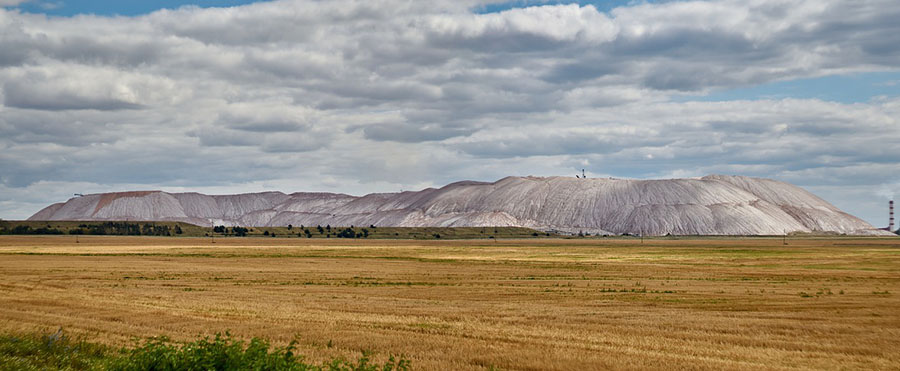TICKERS: EPO, KRN, , POT, RVD, 600500, 297, MOS, URKA, VALE, NPK; AMHPF,
Potash Stocks Offer Profits Ahead of Summer Doldrums: Corey Dias
Interview
Source: Zig Lambo of The Energy Report (5/1/12)
 China and India have returned to the potash markets, stabilizing current prices as long-term demand continues to grow. In this exclusive interview with The Energy Report, Corey Dias, who covers the industry for MGI Securities, brings us up to date on industry developments and shares why Brazil-based companies offer huge potential for prudent investors.
China and India have returned to the potash markets, stabilizing current prices as long-term demand continues to grow. In this exclusive interview with The Energy Report, Corey Dias, who covers the industry for MGI Securities, brings us up to date on industry developments and shares why Brazil-based companies offer huge potential for prudent investors.
The Energy Report: Have there been any significant developments in the potash industry since you last spoke with us in January?
Corey Dias: The biggest change has been that China has actually come back to the market and is buying potash. Earlier this year, neither China nor India were buying, hoping to see a price decline. China has since agreed to purchase about 550,000 tons (t) at $470/t from Israeli potash company ICL Fertilizers (ICL:TASE). Canpotex Ltd. (private) signed a similar-sized agreement with China's Sinofert Holdings Ltd. (297:SEHK) for Q2/12 delivery priced at $470/t. Finally, the Belarusian Potash Company (BPC), the other major potash consortium in the business, signed an agreement with Sinochem International Ltd. (600500:SSE) and CNAMPGC Shanghai Corp. (private) for a price of $470/t. Those buys are underpinning the price as it stands today, slightly below the $500/t spot. It seemed China wanted to hold out for better pricing, but it was inevitable that it would have to come back to the market. India will likely have to do the same soon.
TER: Have your views of the industry's potential changed as a result?
CD: No, nothing has fundamentally changed. This just reinforces my view that fertilizers remain essential to the global agriculture market in order to facilitate growth, improve yields and provide food for burgeoning middle classes throughout the world.
TER: Do you see anything on the horizon that might have a major effect on the market or the prices, either positively or negatively?
CD: I expect some short-term impacts. Both the U.S. and Europe are obviously still facing economic headwinds, which can impact the fertilizer-buying patterns of those regions. That said, I am still bullish on the industry's longer-term prospects. At the end of the day, populations will continue to grow, as will the middle class. Diets will continue to change, and therefore increased fertilizer use is inevitable. I expect the market opportunity for fertilizers such as potash to remain attractive going forward. There still seems to be a lot of positive sentiment out there.
TER: Do you expect any major changes in the number of companies entering into the business in the next 5–10 years?
CD: There will probably be a number of new entrants into the marketplace, especially given how topical potash is at the moment. However, as these projects attempt to advance towards production, many will fall by the wayside due to the difficulty of securing financing for these multibillion-dollar projects. I would assume that the first step of financing a major potash project would involve signing a long-term offtake agreement with a third party looking to secure supply in exchange for an upfront equity investment in a project. This offtake agreement, in turn, could be used as a form of collateral for project debt. Furthermore, not all of the output from these potash projects is going to be necessary from a demand point of view. A number of potash producers have new Brownfield projects that could help meet a significant portion of the expected increased demand for potash. That may not leave a lot of room for new entrants.
TER: Do you expect bigger companies to take over smaller projects that can't finance themselves?
CD: I would think so, assuming that the smaller projects provide some kind of strategic value to the acquirer. That said, many large producers already have an inventory of deposits or projects they can use to expand production without seeking other acquisitions.
TER: Is location the primary factor in determining which projects are "strategic?"
CD: Yes. If one is operating a potash mine in Brazil, one has an internal market that could absorb one's entire potash output. A company that wants to enter the potash market in a cost-effective manner would certainly aim to buy an asset in Brazil in order to benefit from the significant transportation price advantage expected to be enjoyed by the local potash producers. Moreover, Brazil imports over 90% of its current potash needs and, therefore, the Brazilian government is encouraging local projects to be built in order for the country to reach fertilizer independence by 2020.
TER: How have the major players performed during the first quarter of this year?
CD: Mosaic reported significantly lower sales numbers year over year, as did Potash Corp. This is unsurprising, given that China and India were not participating. Unsurprisingly, both Potash Corp. (POT:TSX; POT:NYSE) and The Mosaic Company (MOS:NYSE) have reduced production twice recently. In Eastern Europe, Uralkali (URKA:RTS; URKA:MCX; URKA:LSE) also reduced its production forecast. These companies are likely reducing production to preserve the current $500/t spot price and will probably continue to do so in order to avoid another price collapse similar to what took place a few years ago. Remember that Potash Corp., Uralkali and Mosaic are each tied to regional consortiums—Canpotex and BPC—and probably represent between 60% and 70% of the supply side of the market, so their actions are quite influential with regard to the rest of the market.
TER: What's been going on with the smaller companies you cover in the last three months?
CD: The only junior potash company I was covering when we first spoke was Passport Potash Inc. (PPI:TSX.V; PPRTF:OTCQX). Since then I've added five other names. Passport released an NI 43-101 resource estimate for its Holbrook Basin potash deposit, which officially confirmed the existence of potash on its property. While the deposit is relatively low-grade when compared to Saskatchewan deposits, it is also quite shallow, which lends itself to conventional mining methods. This is the first of many milestones that will move the Passport story forward. I expect more and more positive news to come from the company in the next few months, including the release of a Preliminary Economic Assessment (PEA) by the end of 2012 that should provide a boost to the stock price.
Karnalyte Resources Inc. (KRN:TSX) had to provide clarification to the Alberta Securities Commission over a filing it made related to its updated technical report before Christmas. There was supposed to be an equity financing around the time of the report release, which subsequently didn't take place due to delays related to the technical report. In the absence of clear information with regard to the delay, the market assumed the worst, so the stock price started to slide. Fortunately, the updated technical report was finally released at the end of March and, in fact, some of the numbers were an improvement over the previous technical report.
We still really like Karnalyte. The fact that it is planning to go into production in 2014 - ahead of a number of its peers - puts it in a great position to attract strategic investors interested in an offtake agreement which, in turn, could facilitate debt financing for plant construction.
CD: I also cover Western Potash Corp. (WPX:TSX.V). Western has one of the largest recoverable potash resources in the junior potash developer universe, and three other companies with deposits of similar size in Saskatchewan have been bought by larger entities such as BHP Billiton and K+S Aktiengesellschaft. This could make Western an acquisition target. The Company is currently in discussions with overseas potash buyers with regard to securing an offtake agreement. If Western is successful, the effect on the stock price would be extremely positive.
TER: How about Rio Verde Minerals Development Corp. (RVD:TSX)?
CD: I visited the Company's assets in Brazil a couple of weeks ago. It's a very interesting company aiming to produce both phosphate and potash. In the short term, the Company's first phosphate project is expected to commence production in Q113, thereby providing some cash flow to somewhat mitigate share dilution as it moves its first potash project forward. The important thing about Rio Verde is that it's operating in a market that has significant potash demand with very little domestic supply. The only potash mine currently operating in Brazil is run by Vale S.A. (VALE:NYSE) and produces less than one million tons a year (Mt/y). Demand for potash in Brazil in 2011 was over 7 Mt/y. So there's a significant gap that needs to be filled. In addition, shipping from North America to the Brazilian fertilizer markets adds another $150–200/t in costs. A domestic producer could clearly save buyers a lot of money and improve its own the bottom line.
TER: Could Brazil be the next China or India in terms of potash demand?
CD: Brazil is already bigger than India when it comes to potash demand, and not far behind China. Its combination of fertilizer-intensive crops, low fertilizer application rates and little domestic potash supply makes it an ideal market for potash suppliers. Moreover, Brazil probably has the highest amount of available arable land in the world and the water necessary to irrigate it, which means that it has an opportunity to become an even greater agricultural powerhouse.
TER: What about Encanto Potash Corp. (EPO:TSX.V)?
CD: Encanto is another appealing company. It's an interesting potash play because it involves a First Nations group called the Muskowekwan. Encanto has increased the size of its land package by more than threefold recently, which resulted in an increased potash resource estimate announced in an updated report released in March. The Company has two memorandums of understanding (MOUs) signed with other First Nations groups within Saskatchewan, which means that it could potentially replicate its Muskowekwan junior venture (JV) with these other two groups. That could make the company significantly larger than it is today. Encanto's PEA states that it is aiming to produce 2.5 Mt/y and has alluded to the potential of doubling that output, based solely on its Muskowekwan JV. Output could be significantly higher should either or both of Encanto's MOUs be successful.
TER: Looking at the projected price-to-earnings ratios on smaller companies that are planning to be in production in the next two to five years, it seems the markets are not giving them enough credit at this point. Are investors just waiting to see whether things turn out as expected?
CD: As we discussed earlier, not all of these potash projects will reach the production stage. So the market is taking a wait-and-see approach until project financing is secured and construction and production actually starts. Right now the companies basically trade based on the milestones that they've reached. A company will start with an NI 43-101 resource estimate and then it will perform an economic analysis on the project in order to determine the project's viability, whether it's a PEA or a prefeasibility study (PFS). Even when an economic assessment is completed, the project will still have to be constructed. At that point, the ability to finance the cost of building a production plant becomes a big question.
TER: You just initiated coverage on March 2nd on Verde Potash (NPK:TSX.V). What's going on with that one?
CD: Verde is another junior potash developer with assets in Brazil. The company plans to produce conventional potash using glauconite, which is a green rock that can be found on the surface of Verde's property. The company is planning to use a method called the Cambridge process, which was developed as a collaboration between Verde and a professor at the University of Cambridge in the U.K. The company recently released a positive PEA and expects to begin production in 2015, which is still ahead of many other junior developers. Obviously, that should provide Verde with an early-mover advantage in a country that is a major producer of fertilizer-intensive crops and that has very little domestic potash production. Verde seems to have a great opportunity to become one of the major players in the potash space.
TER: Do you expect Verde to have little difficulty financing its project?
CD: I think that would be the case, because the Brazilian government is very interested in becoming fertilizer-independent by 2020. This goal is even more poignant given that, in 2011, Brazil imported 92% of its potash requirements. To this end, the government has lined up lenders or partners who would be willing to help fund the production of these projects.
TER: What kind of market performance do you expect from these stocks as we head into the summer doldrums?
CD: A lot of the junior and small-cap stocks have been negatively affected in the current market environment and the stocks in the junior potash developer sector are no exception. Those are the ones that investors usually abandon first whenever market sentiment turns negative. It might take until the fall for these stocks to start rebounding. However, falling prices present opportunities for accumulation before the summer doldrums really do kick in and volumes completely dry up. I expect to see an uptick, certainly towards the end of the summer and into the early fall.
TER: We appreciate your updates and insights.
CD: You're very welcome.
Corey Dias has worked in the capital markets industry since 2003 and has spent eight years in institutional equity research and institutional equity sales. In addition, he has worked for a U.S. hedge fund, where he shared responsibility for the running of a $400M portfolio and sought out assets for private equity investment on behalf of the fund. Mr. Dias holds a Master of Business Administration from the Richard Ivey School of Business at the University of Western Ontario.
Want to read more exclusive Energy Report interviews like this? Sign up for our free e-newsletter, and you'll learn when new articles have been published. To see a list of recent interviews with industry analysts and commentators, visit our Exclusive Interviews page.
DISCLOSURE:
1) Zig Lambo of The Energy Report conducted this interview. He personally and/or his family own shares of the following companies mentioned in this interview: None.
2) The following companies mentioned in the interview are sponsors of The Energy Report: Karnalyte Resources Inc., Passport Potash Inc. and Verde Potash. Streetwise Reports does not accept stock in exchange for services.
3) Corey Dias: I personally and/or my family own shares of the following companies mentioned in this interview: None. I personally and/or my family am paid by the following companies mentioned in this interview: None. I was not paid by Streetwise Reports for participating in this story.
Corey Dias: The biggest change has been that China has actually come back to the market and is buying potash. Earlier this year, neither China nor India were buying, hoping to see a price decline. China has since agreed to purchase about 550,000 tons (t) at $470/t from Israeli potash company ICL Fertilizers (ICL:TASE). Canpotex Ltd. (private) signed a similar-sized agreement with China's Sinofert Holdings Ltd. (297:SEHK) for Q2/12 delivery priced at $470/t. Finally, the Belarusian Potash Company (BPC), the other major potash consortium in the business, signed an agreement with Sinochem International Ltd. (600500:SSE) and CNAMPGC Shanghai Corp. (private) for a price of $470/t. Those buys are underpinning the price as it stands today, slightly below the $500/t spot. It seemed China wanted to hold out for better pricing, but it was inevitable that it would have to come back to the market. India will likely have to do the same soon.
TER: Have your views of the industry's potential changed as a result?
CD: No, nothing has fundamentally changed. This just reinforces my view that fertilizers remain essential to the global agriculture market in order to facilitate growth, improve yields and provide food for burgeoning middle classes throughout the world.
TER: Do you see anything on the horizon that might have a major effect on the market or the prices, either positively or negatively?
CD: I expect some short-term impacts. Both the U.S. and Europe are obviously still facing economic headwinds, which can impact the fertilizer-buying patterns of those regions. That said, I am still bullish on the industry's longer-term prospects. At the end of the day, populations will continue to grow, as will the middle class. Diets will continue to change, and therefore increased fertilizer use is inevitable. I expect the market opportunity for fertilizers such as potash to remain attractive going forward. There still seems to be a lot of positive sentiment out there.
TER: Do you expect any major changes in the number of companies entering into the business in the next 5–10 years?
CD: There will probably be a number of new entrants into the marketplace, especially given how topical potash is at the moment. However, as these projects attempt to advance towards production, many will fall by the wayside due to the difficulty of securing financing for these multibillion-dollar projects. I would assume that the first step of financing a major potash project would involve signing a long-term offtake agreement with a third party looking to secure supply in exchange for an upfront equity investment in a project. This offtake agreement, in turn, could be used as a form of collateral for project debt. Furthermore, not all of the output from these potash projects is going to be necessary from a demand point of view. A number of potash producers have new Brownfield projects that could help meet a significant portion of the expected increased demand for potash. That may not leave a lot of room for new entrants.
TER: Do you expect bigger companies to take over smaller projects that can't finance themselves?
CD: I would think so, assuming that the smaller projects provide some kind of strategic value to the acquirer. That said, many large producers already have an inventory of deposits or projects they can use to expand production without seeking other acquisitions.
TER: Is location the primary factor in determining which projects are "strategic?"
CD: Yes. If one is operating a potash mine in Brazil, one has an internal market that could absorb one's entire potash output. A company that wants to enter the potash market in a cost-effective manner would certainly aim to buy an asset in Brazil in order to benefit from the significant transportation price advantage expected to be enjoyed by the local potash producers. Moreover, Brazil imports over 90% of its current potash needs and, therefore, the Brazilian government is encouraging local projects to be built in order for the country to reach fertilizer independence by 2020.
TER: How have the major players performed during the first quarter of this year?
CD: Mosaic reported significantly lower sales numbers year over year, as did Potash Corp. This is unsurprising, given that China and India were not participating. Unsurprisingly, both Potash Corp. (POT:TSX; POT:NYSE) and The Mosaic Company (MOS:NYSE) have reduced production twice recently. In Eastern Europe, Uralkali (URKA:RTS; URKA:MCX; URKA:LSE) also reduced its production forecast. These companies are likely reducing production to preserve the current $500/t spot price and will probably continue to do so in order to avoid another price collapse similar to what took place a few years ago. Remember that Potash Corp., Uralkali and Mosaic are each tied to regional consortiums—Canpotex and BPC—and probably represent between 60% and 70% of the supply side of the market, so their actions are quite influential with regard to the rest of the market.
TER: What's been going on with the smaller companies you cover in the last three months?
CD: The only junior potash company I was covering when we first spoke was Passport Potash Inc. (PPI:TSX.V; PPRTF:OTCQX). Since then I've added five other names. Passport released an NI 43-101 resource estimate for its Holbrook Basin potash deposit, which officially confirmed the existence of potash on its property. While the deposit is relatively low-grade when compared to Saskatchewan deposits, it is also quite shallow, which lends itself to conventional mining methods. This is the first of many milestones that will move the Passport story forward. I expect more and more positive news to come from the company in the next few months, including the release of a Preliminary Economic Assessment (PEA) by the end of 2012 that should provide a boost to the stock price.
Karnalyte Resources Inc. (KRN:TSX) had to provide clarification to the Alberta Securities Commission over a filing it made related to its updated technical report before Christmas. There was supposed to be an equity financing around the time of the report release, which subsequently didn't take place due to delays related to the technical report. In the absence of clear information with regard to the delay, the market assumed the worst, so the stock price started to slide. Fortunately, the updated technical report was finally released at the end of March and, in fact, some of the numbers were an improvement over the previous technical report.
We still really like Karnalyte. The fact that it is planning to go into production in 2014 - ahead of a number of its peers - puts it in a great position to attract strategic investors interested in an offtake agreement which, in turn, could facilitate debt financing for plant construction.
CD: I also cover Western Potash Corp. (WPX:TSX.V). Western has one of the largest recoverable potash resources in the junior potash developer universe, and three other companies with deposits of similar size in Saskatchewan have been bought by larger entities such as BHP Billiton and K+S Aktiengesellschaft. This could make Western an acquisition target. The Company is currently in discussions with overseas potash buyers with regard to securing an offtake agreement. If Western is successful, the effect on the stock price would be extremely positive.
TER: How about Rio Verde Minerals Development Corp. (RVD:TSX)?
CD: I visited the Company's assets in Brazil a couple of weeks ago. It's a very interesting company aiming to produce both phosphate and potash. In the short term, the Company's first phosphate project is expected to commence production in Q113, thereby providing some cash flow to somewhat mitigate share dilution as it moves its first potash project forward. The important thing about Rio Verde is that it's operating in a market that has significant potash demand with very little domestic supply. The only potash mine currently operating in Brazil is run by Vale S.A. (VALE:NYSE) and produces less than one million tons a year (Mt/y). Demand for potash in Brazil in 2011 was over 7 Mt/y. So there's a significant gap that needs to be filled. In addition, shipping from North America to the Brazilian fertilizer markets adds another $150–200/t in costs. A domestic producer could clearly save buyers a lot of money and improve its own the bottom line.
TER: Could Brazil be the next China or India in terms of potash demand?
CD: Brazil is already bigger than India when it comes to potash demand, and not far behind China. Its combination of fertilizer-intensive crops, low fertilizer application rates and little domestic potash supply makes it an ideal market for potash suppliers. Moreover, Brazil probably has the highest amount of available arable land in the world and the water necessary to irrigate it, which means that it has an opportunity to become an even greater agricultural powerhouse.
TER: What about Encanto Potash Corp. (EPO:TSX.V)?
CD: Encanto is another appealing company. It's an interesting potash play because it involves a First Nations group called the Muskowekwan. Encanto has increased the size of its land package by more than threefold recently, which resulted in an increased potash resource estimate announced in an updated report released in March. The Company has two memorandums of understanding (MOUs) signed with other First Nations groups within Saskatchewan, which means that it could potentially replicate its Muskowekwan junior venture (JV) with these other two groups. That could make the company significantly larger than it is today. Encanto's PEA states that it is aiming to produce 2.5 Mt/y and has alluded to the potential of doubling that output, based solely on its Muskowekwan JV. Output could be significantly higher should either or both of Encanto's MOUs be successful.
TER: Looking at the projected price-to-earnings ratios on smaller companies that are planning to be in production in the next two to five years, it seems the markets are not giving them enough credit at this point. Are investors just waiting to see whether things turn out as expected?
CD: As we discussed earlier, not all of these potash projects will reach the production stage. So the market is taking a wait-and-see approach until project financing is secured and construction and production actually starts. Right now the companies basically trade based on the milestones that they've reached. A company will start with an NI 43-101 resource estimate and then it will perform an economic analysis on the project in order to determine the project's viability, whether it's a PEA or a prefeasibility study (PFS). Even when an economic assessment is completed, the project will still have to be constructed. At that point, the ability to finance the cost of building a production plant becomes a big question.
TER: You just initiated coverage on March 2nd on Verde Potash (NPK:TSX.V). What's going on with that one?
CD: Verde is another junior potash developer with assets in Brazil. The company plans to produce conventional potash using glauconite, which is a green rock that can be found on the surface of Verde's property. The company is planning to use a method called the Cambridge process, which was developed as a collaboration between Verde and a professor at the University of Cambridge in the U.K. The company recently released a positive PEA and expects to begin production in 2015, which is still ahead of many other junior developers. Obviously, that should provide Verde with an early-mover advantage in a country that is a major producer of fertilizer-intensive crops and that has very little domestic potash production. Verde seems to have a great opportunity to become one of the major players in the potash space.
TER: Do you expect Verde to have little difficulty financing its project?
CD: I think that would be the case, because the Brazilian government is very interested in becoming fertilizer-independent by 2020. This goal is even more poignant given that, in 2011, Brazil imported 92% of its potash requirements. To this end, the government has lined up lenders or partners who would be willing to help fund the production of these projects.
TER: What kind of market performance do you expect from these stocks as we head into the summer doldrums?
CD: A lot of the junior and small-cap stocks have been negatively affected in the current market environment and the stocks in the junior potash developer sector are no exception. Those are the ones that investors usually abandon first whenever market sentiment turns negative. It might take until the fall for these stocks to start rebounding. However, falling prices present opportunities for accumulation before the summer doldrums really do kick in and volumes completely dry up. I expect to see an uptick, certainly towards the end of the summer and into the early fall.
TER: We appreciate your updates and insights.
CD: You're very welcome.
Corey Dias has worked in the capital markets industry since 2003 and has spent eight years in institutional equity research and institutional equity sales. In addition, he has worked for a U.S. hedge fund, where he shared responsibility for the running of a $400M portfolio and sought out assets for private equity investment on behalf of the fund. Mr. Dias holds a Master of Business Administration from the Richard Ivey School of Business at the University of Western Ontario.
Want to read more exclusive Energy Report interviews like this? Sign up for our free e-newsletter, and you'll learn when new articles have been published. To see a list of recent interviews with industry analysts and commentators, visit our Exclusive Interviews page.
DISCLOSURE:
1) Zig Lambo of The Energy Report conducted this interview. He personally and/or his family own shares of the following companies mentioned in this interview: None.
2) The following companies mentioned in the interview are sponsors of The Energy Report: Karnalyte Resources Inc., Passport Potash Inc. and Verde Potash. Streetwise Reports does not accept stock in exchange for services.
3) Corey Dias: I personally and/or my family own shares of the following companies mentioned in this interview: None. I personally and/or my family am paid by the following companies mentioned in this interview: None. I was not paid by Streetwise Reports for participating in this story.


























































